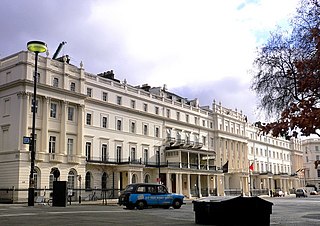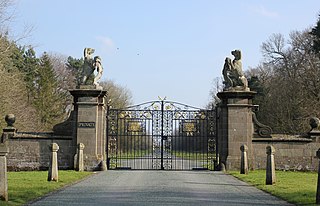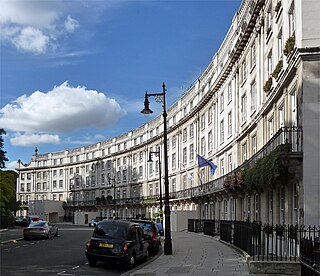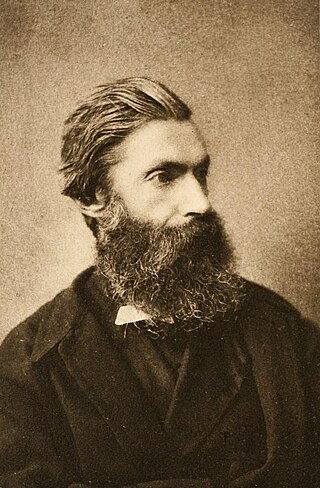
Belgravia is a district in Central London, covering parts of the areas of the City of Westminster and the Royal Borough of Kensington and Chelsea.

Glasgow Caledonian University, informally GCU, Caledonian or Caley, is a public university in Glasgow, Scotland. It was formed in 1993 by the merger of The Queen's College, Glasgow and Glasgow Polytechnic. It is located in the Cowcaddens district, just to the immediate north of the city centre, and is Glasgow's third university, after the University of Glasgow and the University of Strathclyde.

Grosvenor Group Limited is an internationally diversified property group, which traces its origins to 1677 and has its headquarters in London, England. It has a global reach, now in 62 international cities, with offices in 14 of them, operated on behalf of its owners, the Duke of Westminster and his family. It has four regional development and investment businesses and a portfolio of indirect investments. Its sectors include residential, office, retail, industrial, along with hotels.

Carlton House Terrace is a street in the St James's district of the City of Westminster in London. Its principal architectural feature is a pair of terraces, the Western and Eastern terraces, of white stucco-faced houses on the south side of the street, which overlook The Mall and St. James's Park. These terraces were built on Crown land between 1827 and 1832 to overall designs by John Nash, but with detailed input by other architects including Decimus Burton. Construction was overseen by James Pennethorne. Both terrace blocks are Grade I listed buildings. A separate but linked cul de sac at the terrrace's western end is named Carlton Gardens.

The Gresham Club was founded in 1843 and dissolved in 1991. It was named after Thomas Gresham. The Gresham Club's last site was located on Abchurch Lane off King William Street before it was sold to the London Capital Club, which in turn ceased operation in 2018. Following the closure of the London Capital Club, a number of the members relaunched The Gresham Club in 2018 and recreated the raison d'être of its original predecessor.

Cadogan Place is a street in Belgravia, London. It is named after Earl Cadogan and runs parallel to the lower half of Sloane Street. It gives its name to the extensive Cadogan Place Gardens, private communal gardens maintained for Cadogan residents. It is owned by Cadogan Estates.

The Green Room Club was a London-based club, primarily for actors, but also for lovers of theatre, arts and music. It was established in 1877 in a restaurant in Piccadilly Circus, and moved to premises on Adam Street in 1955, where it remained until its closure in 2004.

Belgrave is a historic village in Cheshire, England. The area is part of the estates owned the Dukes of Westminster who have their seat at Eaton Hall, Cheshire. The village has a few houses and the Grosvenor Garden Centre. Belgrave Lodge is located at the western end of the 1.7 mi (2.7 km) main approach to Eaton Hall, which is known as the Belgrave Avenue.

Lowndes Square is a residential garden square at the north-west end of Belgravia, London, SW1. It is formed of archetypal grand terraces of light stucco houses, cream or white. The length of the central rectangular garden is parallel with Sloane Street to the west; visible from the north-west corner is a corner of the Harvey Nichols store, beyond which is Knightsbridge tube station. Ecclesiastically, it remains in a northern projection of one of the parishes of Chelsea, save its east side, in the very small parish of St Paul, Knightsbridge, a division which is mirrored secularly by the boundaries of two London Boroughs.

Wilton Crescent is a street in Belgravia, Central London, comprising a sweeping elegant terrace of Georgian houses and the private communal gardens that the semi-circle looks out upon. The houses were built in the early 19th century and are now Grade II listed buildings. The street is the northern projection of Belgravia and is often taken to fall into the category of London's garden squares.

COMO The Halkin is a 5-star hotel in London, England. It is located at 5–6 Halkin Street in Belgravia, one of London's most affluent districts, just to the east of Belgrave Square. The hotel is operated by COMO Hotels and Resorts. It is considered to be one of the first boutique hotels in London.

The Plumbers Arms is a Grade II listed public house at 14 Lower Belgrave Street, Belgravia, London SW1.

Aaron Adolph Saphir was a Hungarian Jew who converted to Christianity and became a Jewish Presbyterian missionary.

Forbes House is a Grade II listed house at 10 Halkin Street, Belgravia, London SW1.

Halkin Street is a street in Belgravia, London, running south-west to north-east from the north-east corner of Belgrave Square to Grosvenor Place.
This is a list of the etymology of street names in the London district of Belgravia. The following utilises the generally accepted boundaries of the area viz. South Carriage Drive to the north, Grosvenor Gardens/Place/Square to the east, Buckingham Palace Road/Victoria railway line to the south-east and Chelsea Bridge Road, Lower Sloane Street/Sloane Square/Sloane Street to the west.

Grosvenor Crescent is a street in London's Belgravia district, that in December 2017 was ranked as the UK's most expensive residential street, with an average house price of £16,918,000.

Motcomb Street is a street in the City of Westminster's Belgravia district in London. It is known for its luxury fashion shops, such as Christian Louboutin shoes, Stewart Parvin gowns, and the jeweller Carolina Bucci, and was the location of the original Pantechnicon department store.



















